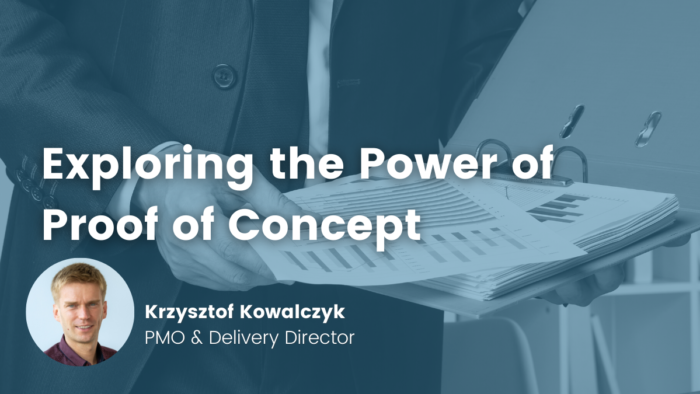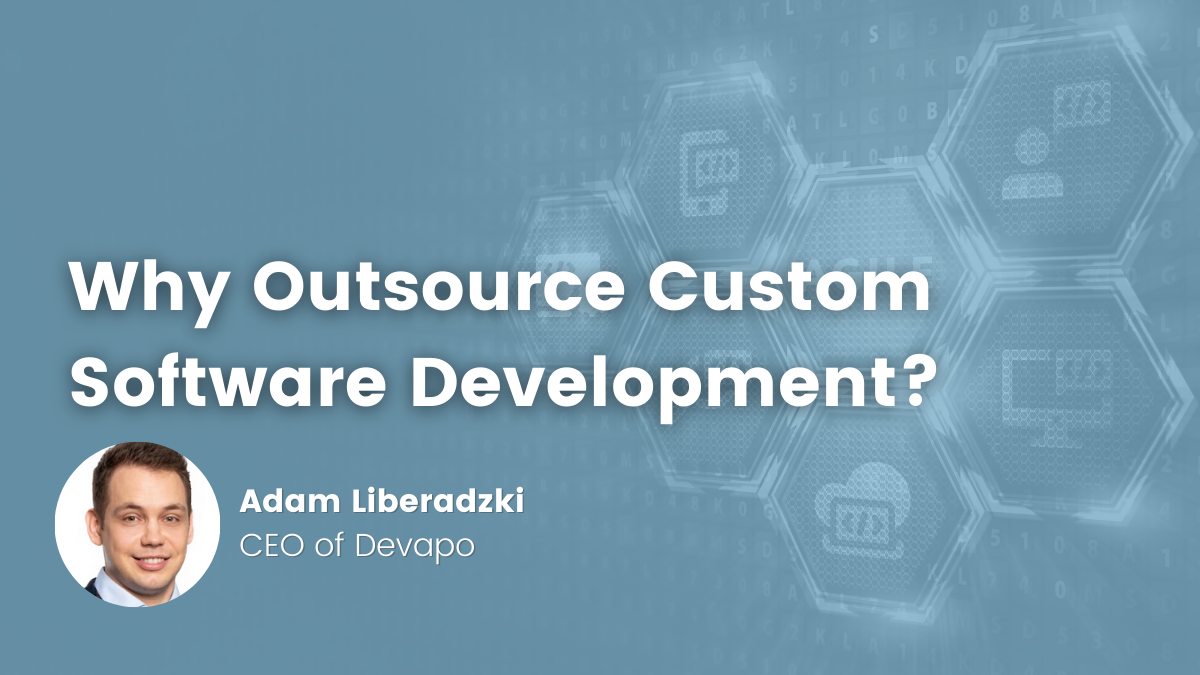- Krzysztof Kowalczyk
- Read in 5 min.
Based on our extensive experience in creating customized technical solutions, I would like to shed light on the intricacies of the Proof of Concept process. Our customers come to us with more or less specific needs, which we address utilizing a variety of technologies. The solutions we develop must not only work flawlessly, but be effectively integrated with the company’s existing systems, so that the entire technological background works like a well-oiled machine and supports the operations of the business.
To achieve that, it is important to go through the proof-of-concept phase, which is still sometimes underestimated. In this article, we’ll explore the Proof of Concept from a business perspective, as I will delve into why it’s an essential to gain practical experience and verifying the viability of innovative ideas before proceeding with actual development.
Understanding Proof of Concept
Proof of Concept (POC) refers to an initial demonstration or experiment to verify the practicality and potential of a particular concept or idea. It bridges the gap between theory and practice, providing a valuable tool for business-oriented innovation. Typically, it should include an implementation that realizes some of the relevant functional and nonfunctional requirements at a basic level to assess the accuracy of the analysis and technical design.
A good supplier prepares environments, first versions of architecture components and some of the steps selected for implementation together with the customer. This is done to enable an assessment of whether the technology or solution is in line with the customer’s needs, goals and expectations, ultimately driving informed decision-making.
Differentiating PoCs from Workshops, Prototype and MVP
I have explained what a Proof of Concept is, so let’s briefly see how it compares to other methods for validating your ideas.
In general, you’ll want to follow the Workshop → PoC → Prototype → MVP order.
Workshops provide an introduction to collaboration. They are the basis for idea generation and problem-solving discussions. With different purposes, such as brainstorming, refining concepts, creating prototypes or conducting user testing, they provide a platform for cross-functional teams to collaborate, share insights and make informed decisions in a structured and facilitated environment.
A prototype demonstrates how the product will work when it is finished. For highly technical product prototypes can show the solution’s underlying mechanisms or if it is a platform that will be used by users, it can be shown as interactive visual wireframes.
Last stage is Minimum Viable Product (MVP). It provides an early version of a product or solution. It includes the basic functionality needed to meet the basic needs of users. Based on feedback, the development team improves the solution.
What are the benefits of using a Proof of Concept?
By implementing PoC, organizations can gain hands-on experience with new technologies, assess their relevance and evaluate the potential impact on their business. This enables decision makers to make informed decisions about integrating innovative solutions, mitigating risks associated with unfamiliar technology, and enabling teams to adapt to new tools and processes.
Before committing significant resources to a project, a well-executed PoC acts as a safeguard. By building a version of the solution with limited functionality, companies can assess its effectiveness, gather user feedback and identify potential flaws or unforeseen challenges. This enables organizations to refine the solution, make adjustments and optimize resource allocation, thus minimizing the risk of failure.
PoC may also reduce the risk of wasted resources by allowing organizations to explore and experiment in a controlled environment. By minimizing the scale of deployment during the PoC phase, organizations can save on the costs associated with full-scale deployment, making this approach efficient and cost-effective.
As a final but not least benefit, increased innovation is a significant factor in my eyes. When ideas are tested, refined and validated, we have the space to find new ways to achieve the goal. PoCs play a key role in the innovation process by facilitating experimentation and iteration. By providing a platform for trial and error, organizations can explore approaches that meet customer needs.
The project manager’s perspective: Maximizing the effectiveness of PoC
Every time we create a PoC for our clients, I try to stick to specific guidelines that allow us to realize the full potential of this verification approach. In my opinion, in order to prepare an effective PoC, it should focus on several key aspects such as:
Understanding Business Needs
Proof of Concept allows us to know and understand our customer’s needs in advance. This helps us, as a supplier to better tailor the solution to the clients’s specific requirements. PoC serves as a powerful communication tool for project managers that enables interaction between the supplier and the customer at an early stage of the project, leading to better understanding.
Building trust
Proof of Concept is also a way to build trust between supplier and customer. Suppliers can demonstrate their knowledge, skills and commitment to providing the right solution. The customer can see how the supplier handles their specific needs and how well it aligns with their expectations. With PoC, the client has the opportunity to evaluate the quality and effectiveness of the solution before committing to a long-term relationship. A positive experience with PoC builds trust between the parties and can lead to further cooperation.
Build confidence and overcome resistance
Complex or innovative projects often face resistance due to uncertainty or fear of change. A well-executed PoC addresses these fears by delivering tangible results and positive outcomes that act as proof of feasibility and success. This leads to increased confidence and support for the project.
Streamline decision-making with data
The proof-of-concept phase enables project managers to collect data, evaluate results and make data-driven decisions. By analyzing the data and insights gathered during PoC, project managers can refine project plans, modify strategies and optimize project execution. This data-driven approach ensures that decisions are based on tangible evidence rather than subjective assumptions.
Summary
Proof of Concept has emerged as a vital methodology for familiarizing with technology and solutions, allowing individuals and organizations to navigate the rapidly changing technology landscape with confidence. PoC enables stakeholders to make informed decisions. In an era where innovation is paramount, embracing Proof of Concept can be the key to unlocking new possibilities and staying ahead in an ever-evolving world.
While it may require an investment of time and money at the beginning, it will certainly pay off in later stages. PoC helps to gain an in-depth understanding of the projects’ needs and identify the best solution, leading to a better tailored offering. With proper testing and verification, we can optimize the work, minimizing the risk of making costly mistakes downstream.
Looking for a custom software service?
See what we can do for you!







